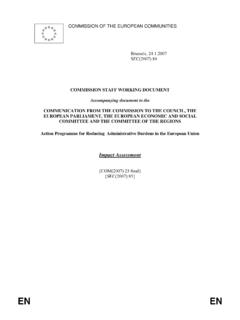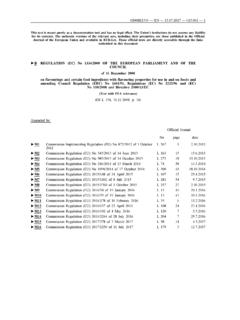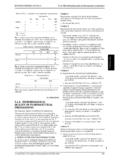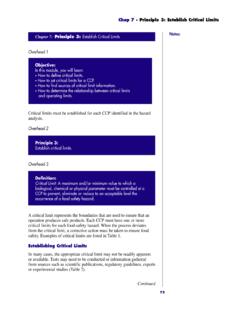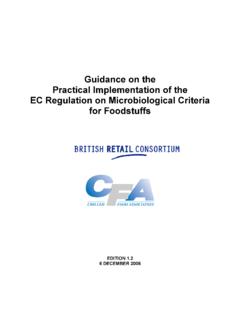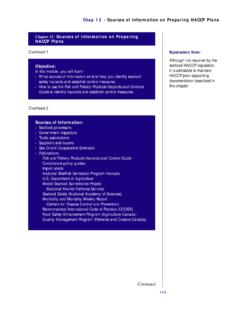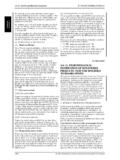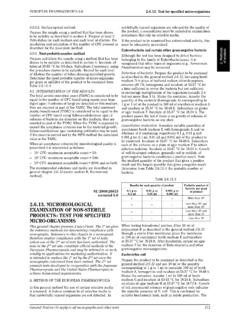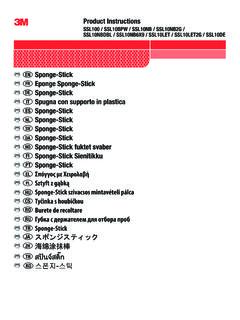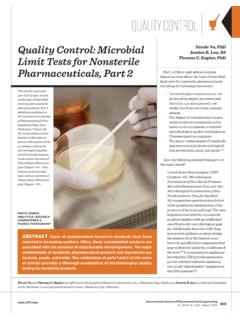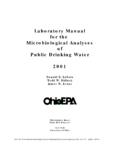Transcription of (Text with EEA relevance) - Food Safety Authority of Ireland
1 I(Acts whose publication is obligatory)COMMISSION REGULATION (EC) No 2073/2005of 15 November 2005on microbiological criteria for foodstuffs (Text with EEA relevance )THE COMMISSION OF THE EUROPEAN COMMUNITIES,Having regard to the Treaty establishing the EuropeanCommunity,Having regard to Regulation (EC) No 852/2004 of theEuropean Parliament and of the Council of 29 April 2004 onthe hygiene of foodstuffs (1), and in particular Articles 4(4)and 12 thereof,Whereas:(1)A high level of protection of public health is one of thefundamental objectives of food law, as laid down inRegulation (EC) No 178/2002 of the European Parlia-ment and of the Council of 28 January 2002 layingdown the general principles and requirements of foodlaw, establishing the European Food Safety Authority andlaying down procedures in matters of food Safety (2).
2 microbiological hazards in foodstuffs form a majorsource of food-borne diseases in humans.(2)Foodstuffs should not contain micro-organisms or theirtoxins or metabolites in quantities that present anunacceptable risk for human health.(3)Regulation (EC) No 178/2002 lays down general foodsafety requirements, according to which food must notbe placed on the market if it is unsafe. Food businessoperators have an obligation to withdraw unsafe foodfrom the market. In order to contribute to the protectionof public health and to prevent differing interpretations,it is appropriate to establish harmonised Safety criteria onthe acceptability of food, in particular as regards thepresence of certain pathogenic micro-organisms.
3 (4) microbiological criteria also give guidance on theacceptability of foodstuffs and their manufacturing,handling and distribution processes. The use of micro-biological criteria should form an integral part of theimplementation of HACCP-based procedures and otherhygiene control measures.(5)The Safety of foodstuffs is mainly ensured by a preventiveapproach, such as implementation of good hygienepractice and application of procedures based on hazardanalysis and critical control point (HACCP) criteria can be used in validation andverification of HACCP procedures and other hygienecontrol measures.
4 It is therefore appropriate to setmicrobiological criteria defining the acceptability of theprocesses, and also food Safety microbiological criteriasetting a limit above which a foodstuff should beconsidered unacceptably contaminated with the micro-organisms for which the criteria are set.(6)According to Article 4 of Regulation (EC) No 852/2004,food business operators are to comply with microbiolo-gical criteria . This should include testing against thevalues set for the criteria through the taking of samples,the conduct of analyses and the implementation ofcorrective actions, in accordance with food law and theinstructions given by the competent Authority .
5 It istherefore appropriate to lay down implementing mea-sures concerning the analytical methods, including,where necessary, the measurement uncertainty, thesampling plan, the microbiological limits, the numberof analytical units that should comply with these , it is appropriate to lay down implementingmeasures concerning the foodstuff to which the criterionapplies, the points of the food chain where the criterionapplies, as well as the actions to be taken when thecriterion is not met. The measures to be taken by thefood business operators in order to ensure compliancewith criteria defining the acceptability of a process mayinclude, among other things, controls of raw materials,hygiene, temperature and shelf-life of the Journal of the European UnionL 338/1(1) OJ L 139, , p.
6 1, corrected by OJ L 226, ,p. 3.(2) OJ L 31, , p. 1. Regulation as amended by Regulation(EC) No 1642/2003 (OJ L 245, , p. 4).(7)Regulation (EC) No 882/2004 of the European Parlia-ment and of the Council of 29 April 2004 on officialcontrols performed to ensure the verification ofcompliance with feed and food law, animal health andanimal welfare rules (1) requires the Member States toensure that official controls are carried out regularly, on arisk basis and with appropriate frequency. Those controlsshould take place at appropriate stages of the production,processing and distribution of food to ensure that thecriteria laid down in this Regulation are complied with byfood business operators.
7 (8)The Communication from the Commission on theCommunity Strategy for setting microbiological criteriafor foodstuffs (2) describes the strategy to lay down andrevise the criteria in Community legislation, as well as theprinciples for the development and application of thecriteria. This strategy should be applied when micro-biological criteria are laid down.(9)The Scientific Committee on Veterinary Measures relatingto Public Health (SCVPH) issued an opinion on23 September 1999 on the evaluation of microbiologicalcriteria for food products of animal origin for humanconsumption. It highlighted the relevance of basingmicrobiological criteria on formal risk assessment andinternationally approved principles.
8 The opinion recom-mends that microbiological criteria should be relevantand effective in relation to consumer health SCVPH proposed, while awaiting formal riskassessments, certain revised criteria as interim measures.(10)The SCVPH issued at the same time a separate opiniononListeria monocytogenes. That opinion recommendedthat it be an objective to keep the concentration ofListeria monocytogenesin food below 100 cfu/g. TheScientific Committee on Food (SCF) agreed with theserecommendations in its opinion of 22 June 2000.(11)The SCVPH adopted an opinion onVibrio vulnificusandVibrio parahaemolyticuson 19 and 20 September 2001.
9 Itconcluded that currently available scientific data do notsupport setting specific criteria for seafood. However, itrecommended that codes of practice should be estab-lished to ensure that good hygiene practice has beenapplied.(12)The SCVPH issued an opinion on Norwalk-like viruses(NLVs, noroviruses) on 30-31 January 2002. In thatopinion it concluded that the conventional faecalindicators are unreliable for demonstrating the presenceor absence of NLVs and that the reliance on faecalbacterial indicator removal for determining shellfishpurification times is unsafe practice. It also recom-mended usingE.
10 Colirather than faecal coliforms toindicate faecal contamination in shellfish harvestingareas, when applying bacterial indicators.(13)On 27 February 2002 the SCF adopted an opinion onspecifications for gelatine in terms of consumer health. Itconcluded that the microbiological criteria set inChapter 4 of Annex II to Council Directive 92/118/EECof 17 December 1992 laying down animal health andpublic health requirements governing trade in andimports into the Community of products not subjectto the said requirements laid down in specific Commu-nity rules referred to in Annex A(I) to Directive 89/662/EEC and, as regards pathogens, to Directive 90/425/EEC (3) in terms of consumer health were excessive, andconsidered it sufficient to apply a mandatory micro-biological criterion for salmonella only.




